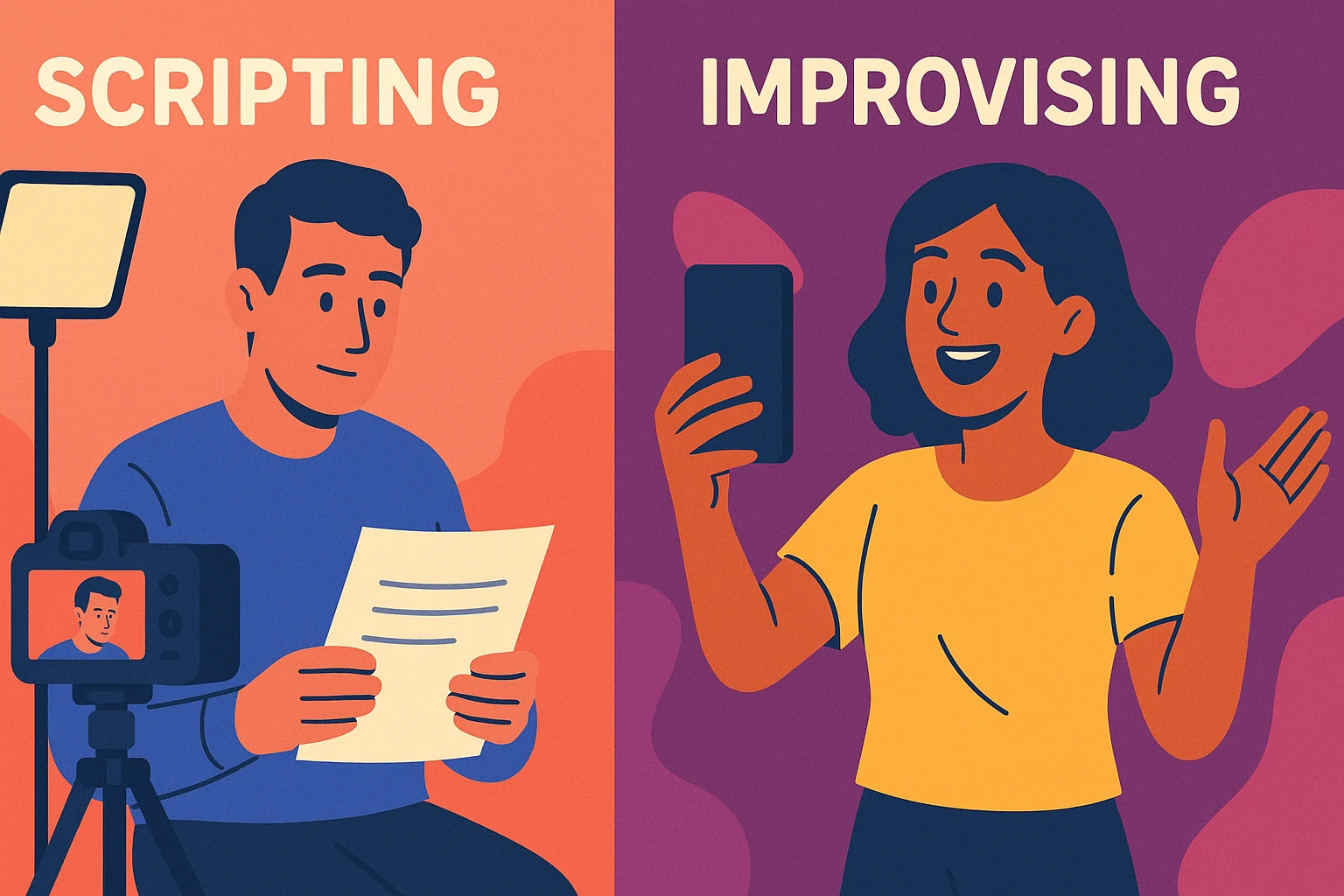Scripting vs. Improvising: Which Works Better for Short Videos?
Short videos are everywhere. Should you plan your lines or wing it? Here’s what actually works.

Short videos are everywhere. TikTok, Instagram Reels, YouTube Shorts—they’re quick, easy to watch, and can reach thousands, even millions, of people. But if you’re the one making them, there’s a real question to answer:
Should you script your videos or improvise?
Both have their perks. Both have their downsides. Let’s break it down in a way that helps you choose what works for you.
What Does Scripting Mean?
Scripting is writing out what you’ll say before you record. You plan the lines. You know the story. You may even rehearse.
It doesn’t mean reading word-for-word like a robot. Good scripts sound natural. They help you stay on point and avoid rambling.
What Is Improvising?
Improvising means you make it up as you go. You might have a topic or idea, but no word-for-word plan. You turn on the camera and speak.
This feels real and loose. You may sound more like a friend than a presenter. But it also comes with risk.
Let’s compare.
Why Some Creators Script
1. You Stay Focused
With a script, you know what you want to say. You don’t forget key points or drift off-topic.
This helps your video stay short and sharp. That matters. Viewers scroll fast. If you ramble, they swipe away.
2. You Sound Clear
Planning helps you choose the best way to explain something. You cut filler words like “uh,” “like,” and “you know.”
That makes your message easier to follow.
3. You Save Time (Later)
It might take longer up front to write a script. But when you edit, it’s faster. You won’t have to cut out long pauses or re-record sections.
4. You Can Add Captions Easily
With a script, you already have the words. That makes it simple to add captions. Captions help people watch your video with the sound off—and many do.
The Downside of Scripting
1. You Might Sound Stiff
If you read a script word-for-word, you risk sounding fake. Viewers can tell. It feels more like a lecture than a real person talking.
To fix this, some creators write in a relaxed tone. They also rehearse until it sounds natural.
2. It Can Take Time
Writing a script takes work. If you’re posting every day, this can feel like a lot. You might feel stuck trying to “get it right.”
Why Some Creators Improvise
1. It Feels Real
When you talk off-the-cuff, you sound more like yourself. This can feel more honest and fun. People like watching creators who seem real, not scripted.
2. It’s Faster (Sometimes)
No writing. No planning. Just hit record and go.
This can save time—if you’re good at it.
3. It Leaves Room for Surprises
Sometimes, great lines pop into your head while recording. That random joke, weird face, or off-topic story? It might be what makes your video go viral.
The Downside of Improvising
1. You Might Ramble
Without a plan, it’s easy to go off-track. You repeat things. You forget your main point. Your short video becomes too long.
Then you have to edit a lot—or start over.
2. You May Miss Key Points
You might forget to say something important. That’s a big problem if you’re teaching, reviewing, or promoting something.
3. It’s Harder to Add Captions
You have to go back and write out what you said. If your thoughts were scattered, this takes longer than you’d think.
What Works Best?
The answer depends on the type of video and who you are.
When Scripting Wins
- Tutorials: You need to explain steps clearly and quickly.
- Product Reviews: You want to hit all the features, pros, and cons.
- Sponsored Posts: Brands want you to follow a brief.
- Time-Limited Videos: You need to pack a lot into 30 seconds.
If you need to teach or sell, scripting helps you stay clear and smooth.
When Improvising Wins
- Storytime Videos: You’re telling a funny or personal story.
- Reactions: You’re showing how you feel in the moment.
- Trends: You’re hopping on a meme or sound fast.
- Skits or Vlogs: You want to show your real self.
These types work better when you feel relaxed and playful. Improvising helps you connect with your viewers.
What About a Mix?
Some of the best creators do both.
They jot down bullet points instead of full scripts. That way, they remember what to say but still sound natural.
You can also script the start and end. This helps you hook the viewer and finish strong. The middle can be looser.
This mix gives you the best of both worlds: clarity without stiffness.
How to Script Without Sounding Scripted
-
Write How You Talk
Use short sentences. Use words you’d say in real life. -
Read It Out Loud
If it sounds weird, change it. -
Practice a Bit
Even just one or two run-throughs can help. -
Use a Teleprompter App
There are free ones. They scroll while you record. Just don’t read like a robot.
How to Improvise Without Losing the Plot
-
Think Before You Record
Take 30 seconds to plan what you want to say. -
Stick to One Idea
Don’t try to cover too much. One clear point is enough. -
Keep It Short
Aim for 30–60 seconds. Long clips lose viewers. -
Do a Few Takes
Even when improvising, your third try is often better than the first.
Final Thoughts
Scripting and improvising both work. Each has its place. What matters most is the content and how it feels to your viewers.
If you’re new, try both. Watch your videos. See what feels better to you and your audience.
Then stick with what works.
Or don’t.
You can always switch it up.
The best creators are the ones who test, learn, and keep creating.